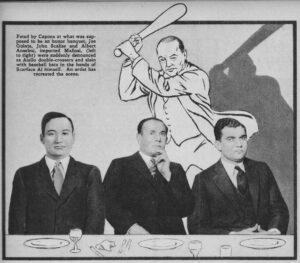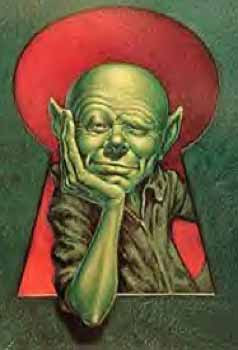AND now for something completely different . . . from our last story, that is, as we offer an SFF tale with a much lighter tone:
"Operation Peep."
(a.k.a. "Pawley's Peepholes").
First appearance: Suspense, Summer 1951.
Reprints pages:
As "Operation Peep" (ISFDb HERE).
As "Pawley's Peepholes" (ISFDb HERE).
Short story (13 pages).
Online at SFFAudio (HERE).
Note: The hardcover edition of The Seeds of Time containing "Pawley's Peepholes" is on The Luminist Archives (HERE; go
to text page 112.)
"With parts of people poking right through the walls at most embarrassing moments, life became intolerable. Only an 'invention' could restore precious peace and privacy . . ."
THE main problem with most technologies is that they can be used for good or ill. The sandlot baseball bat and the carpenter's reliable claw hammer, for instance, make excellent murder weapons. We've always maintained, however, that the ideal weapon doesn't maim or kill but instead controls the victim, rendering him unable to resist. It's a lot less messy and saves time and money. Which takes us to today's story: An "inventor" who doesn't know he's an inventor contrives a solution (but not an invention) to a situation that is driving everybody bonkers. It's essentially the same problem that made pest control companies into corporate giants, but it is a lot less messy, saving not just time and money but, most importantly, everyone's sanity . . .
Main characters:
~ Jerry, the narrator ("It struck me all of a heap—so simple"); Sally ("We've got two ways of using inventions"); Patrolman Walsh ("found a head sitting up on the sidewalk"); Mrs. Rourke and Miss Farrell ("But there was nothing to be seen on the ceiling"); Jimmy Lindlin ("his hobby is collecting queer facts"); the traffic cop ("You could see his nostrils kind of spread, the way a horse's do"); Anna ("Naturally, I screamed at once"); and Jerry's boss ("First bust-up in twenty years").
References and resources:
- "a new kind of pink elephant":
"'Seeing pink elephants' is a euphemism for hallucinations caused by delirium tremens or alcoholic hallucinosis, especially the former. The term dates back to at least the early 20th century, emerging from earlier idioms about seeing snakes and other creatures. An alcoholic character in Jack London's 1913 novel John Barleycorn makes reference to the hallucination of 'blue mice and pink elephants' while describing the two different types of men that consume alcohol excessively. Another notable instance of the appearance of pink elephants in popular culture is the 'Pink Elephants on Parade' section of the 1941 Walt Disney animated film Dumbo." (Wikipedia HERE.)
- "You couldn't expect a person to be kind of broadcast and then come together again any old place":
Just don't tell TV producers that: "In the original [Star Trek] series, beaming to and from the transporter chamber was a necessity." (Wikipedia HERE; see under "Technological and scientific restrictions.")
- "I'd think Oak Ridge":
Thanks to Hiroshima and Nagasaki, everybody in 1951 knew about Oak Ridge:
"Oak Ridge was established in 1942 as a production site for the Manhattan Project—the massive American, British, and Canadian operation that developed the atomic bomb. In 1942, the United States federal government chose the area as a site for developing materials for the Manhattan Project. Major General Leslie Groves, military head of the Manhattan Project, liked the area for several reasons. Its relatively low population made acquisition affordable, yet the area was accessible by highway and rail, and utilities such as water and electricity were readily available with the recent completion of Norris Dam. The project location was established within a 17-mile-long (27 km) valley. This feature was linear and partitioned by several ridges, providing natural protection against the spread of disasters at the four major industrial plants—so the plants would not blow up 'like firecrackers on a string'." (Wikipedia HERE; also see HERE.)
- "the imminence of Judgment Day":
"Christianity considers the Second Coming of Jesus Christ to entail the final judgment by God of all people who have ever lived, resulting in the approval of some and the penalizing of most. The concept is found in all the canonical gospels, particularly in the Gospel of Matthew. The Christian tradition is also followed by Islam, where it is mentioned in many chapters of the Quran, according to some interpretations." (Wikipedia HERE.)
- "batteries of Klieg lights":
"A Klieg light is an intense carbon arc lamp especially used in filmmaking. It is named after inventor John Kliegl and his brother Anton Kliegl. Klieg lights usually have a Fresnel lens with a spherical reflector or an ellipsoidal reflector with a lens train containing two plano-convex lenses or a single step lens. The carbon-arc source was so bright that it allowed film directors to shoot daytime scenes at night. The ultraviolet rays produced by the light also led to some actors developing an eye inflammation referred to as 'Klieg eye'." (Wikipedia HERE.)
- "out sight, out of mind":
"When something is not nearby, it is forgotten about." (Wiktionary HERE.)
- "Peep shows" had an innocuous beginning several centuries ago, steadily losing their innocence over time:
"A raree show, peep show or peep box is an exhibition of pictures or objects (or a combination of both), viewed through a small hole or magnifying glass. In 17th and 18th century Europe, it was a popular form of entertainment provided by wandering showmen. Peep shows, also known as peep box or raree show ('rarity show') can be traced back to the early modern period (15th century in Europe) and are known in various cultures." (Wikipedia HERE.)
Technology improved: "The Kinetoscope is an early motion picture exhibition device, designed for films to be viewed by one person at a time through a peephole viewer window. The Kinetoscope was not a movie projector, but it introduced the basic approach that would become the standard for all cinematic projection before the advent of video: it created the illusion of movement by conveying a strip of perforated film bearing sequential images over a light source with a high-speed shutter. First described in conceptual terms by U.S. inventor Thomas Edison in 1888, it was largely developed by his employee William Kennedy Laurie Dickson between 1889 and 1892." (Wikipedia HERE; also see Rivera Inventions HERE.)
Another version: "The Mutoscope is an early motion picture device, invented by W. K. L. Dickson and Herman Casler and granted U.S. patent 549309A to Herman Casler on November 5, 1895. Like Thomas Edison's Kinetoscope, it did not project on a screen and provided viewing to only one person at a time." (Wikipedia HERE; also see HERE.)
- The FBI is tasked with keeping track of homicides in the U.S.; see Statista (HERE) for the 2022 data. We're often told that even Al Capone used a baseball bat on at least one occasion (Wikipedia HERE), but did he? (Gangland Wire HERE.)
- Would civilization collapse completely if personal privacy simply vanished? Fredric Brown envisioned it (and he did so, please note, several years after today's author got there first) in his story Martians, Go Home (1955) (WARNING! SPOILERS! Wikipedia HERE; online at Archive.org HERE, borrow only; free read at The Luminist Archives HERE.) (Filmed in 1990: WARNING! SPOILERS! HERE).
The bottom line:
"Science fiction is any idea that occurs in the head and doesn't exist yet, but soon will, and will change everything for everybody, and nothing will ever be the same again. As soon as you have an idea that changes some small part of the world you are writing science fiction. It is always the art of the possible, never the impossible."
Unless otherwise noted, all bibliographical data are derived from The FictionMags Index created by William G. Contento & edited by Phil Stephensen-Payne.
~~~~~~~~~~~~~~~~~~~~~~~~~~~~~~~~~~~~~~~~~~~~~~~~~~~~~~~~~~~~~~~~~~~~~~~~~~~~

.jpg)
.jpg)
.jpg)
.jpg)



.jpg)


No comments:
Post a Comment